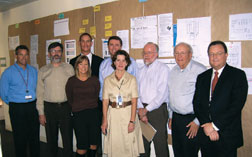 Nadine M. Post / ENR The team for Cathedral Hill Hospital is charged with Sutter�s grandest lean project.
|
"I've been waiting for 27 years to do a job like this....No more finger-pointing....It’s about trusting your partners or it doesn’t work....We all sink or swim together....Nobody cuts corners....We are ‘incentivized’ to help each other.... There is no ‘we’ or ‘they’....It’s one team....Our goals are ligned....We share risk and reward with the owner and contractor.”
Did the professionals making these comments drink construction’s magic elixir? Close to it, say NBBJ’s Jay Halleran and David Swain. Their dream job is the $360-million Palo Alto Medical Foundation’s San Carlos Center, under design by the Seattle-based architect for Sutter Health, Sacramento.
 Susan Lohwasser / ENR Triumvirate. Leader Pixley huddles with his lean aides, Long (left) and Lichtig (center).
|
Sutter is a system of nonprofit hospitals and doctors’ groups in northern California. It has $5.5 billion of development on its plate. [As a nonprofit, Sutter is not included on ENR’s list of Top Owners.]
The magic elixir is Sutter’s seismic shift in project management style, first to Lean Project Delivery and then to LPD plus a relational contract. The contract is signed by the major players, including but not limited to the owner, architect and constructor. Thus, the team sinks or swims together.
In Sutter’s brave new world of lean construction, the traditional “command and control” mentality of project management is gone. Gone are most lump-sum, low-bid contracts. Gone are guaranteed maximum prices. Gone are in flated bids to cover risk. Gone are the adversaries. Gone are most requests for information. And, so far, gone are costly claims.
The transformation is largely thanks to 19-year Sutter veteran Dave Pixley, project management director for Sutter Facility Planning & Development. Pixley’s job is to put Sutter’s capital program in place, on time and budget, by 2013. That’s not a small task, especially during a seller’s market. Hospitals are risky. In seismic California, they are monsters, thanks to the iron rules of the state.
“We knew early on that this was a huge opportunity for us to face one of the historic problem areas in our delivery process,” says Pixley, who sold Sutter on lean with the help of Sutter’s outside counsel, Will Lichtig, and Sutter’s system lean coordinator, David Long.
|
“Sutter realized from the first that success depended on changing the common sense in the industry, a level of change not attempted before,” says Gregory A. Howell, co-founder in 1997 of Louisville, Colo.-based Lean Construction Institute (www.leanconstruction.org), to which Sutter belongs. Howell, in his capacity as a principal of Lean Project Consulting, Louisville, also helped Sutter shift to LPD.
Word of Sutter’s cultural transformation, which some call integrated project delivery, is resonating throughout the industry. Not yet three years old, the relational contract has already helped shape a model relational contract, the recently released ConsensusDocs 300. NBBJ modeled its own relational contract after Sutter’s. The Sutter contract, made available to LCI members, also has been used by at least one other health-care builder.
LPD is a trademarked project production process adapted from manufacturing by LCI. It is designed to eliminate waste in construction through increased collaboration, predictability, innovation and accountability
But Sutter’s lean trek has been tough. “We were loaded with excitement about the promise of lean but were without a clue...
 Related Links:
Related Links: 

Post a comment to this article
Report Abusive Comment